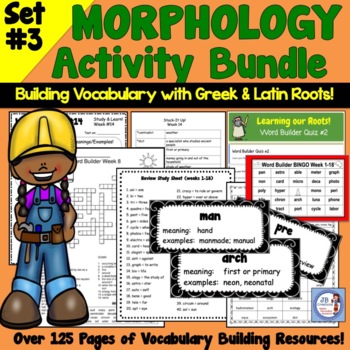Sunday, September 18, 2022
We all know how difficult it is to be out a day for school. I think we’ve all had that inner struggle of determining whether you feel bad enough to call in for a sick day. It’s just so HARD to get ready for a substitute on the fly.
Our district actually required us to have 3 day’s worth of plans ready to go this year (we definitely are experiencing a sub shortage in our area). I wanted to make sure the resources that I would leave for my students were flexible enough to fit in at any time or place in the curriculum, but also full of meaningful learning and not just busy work. So I got busy creating!
I developed 3 days worth of Language Arts, Math, Social Studies, Science, and Morning work activities (15 activities in all!) that can be tailored to suit individual classroom needs. Complete teacher instructions are included for EVERY ACTIVITY! This makes it easy to pick and choose the subjects/activities you want to leave for any sub you may have.
I really wanted to leave activities that were engaging for my kids. Keeping that in mind, I included several class games, a reader’s theater, basic experiments, and puzzles in addition to more typical review activities.
Saturday, September 10, 2022
As the need for more specific literacy based instruction increases in the intermediate classroom, I have really stepped up my game with vocabulary in the past year or so.
It has been proven time and again that the larger a child’s vocabulary, the stronger reader they will become. But, how can we make sure our students are learning all of the necessary vocabulary they will need? How can we possibly choose the correct word lists to focus on? The simple answer is....it’s impossible! There are just too many words in the English language.
But, there is a powerful tool that you can teach your students to make that seemingly impossible mountain of words easier to attack. And that tool is MORPHOLOGY!
Simply put, morphology is the study of the most common Greek and Latin affixes (sometimes referred to as “root” words) that hold meaning. By having students learn just 1 new root’s meaning, they can later apply that to dozens of words that contain it; giving them a solid advantage when it comes to attempting to learn that new vocabulary word!
I have spent the past few years incorporating morphology into my language arts classes and have been OVERWHELMED with the success and speed with which my students have increased their vocabulary. Even more exciting is that what I am teaching them is a LIFELONG skill that will continue to help for years to come!
The program I have developed and designed contains 25 weeks worth of word lists, study sheets, flashcards, individual practice puzzles and activities, weekly Google Form quizzes, whole class review games, and summative assessments for each quarter. Students will learn approximately 35 new roots each 9 weeks and continue to practice previously introduced roots as well. The SPIRAL nature of this program is another one of its very effective features! By then end of the year, students will have a strong foundation on over 100 of the most common and frequently used roots!
Here is how I go about implementing my program. It typically only takes about 10-15 minutes per day of my language arts instruction time!
MONDAY: I introduce the new roots with my study sheet. We spend time reviewing the 5 “old” roots, and then really talk about the new roots for the week. I have a set of large “word wall” cards (included) that I hang up on the board for the week for them to refer to. We brainstorm together a good definition for the example words after they have learned what each root means. I will pass out a puzzle for homework to be completed by Friday.
TUESDAY: We cut out the vocabulary flashcards for the week and put them in a baggie after a quick review of the meanings. We play a few rounds of the “I have, Who has” game.
WEDNESDAY: Students will work on their “stack it up” activity independently. They may use the word cards if they choose.
THURSDAY: Based on how the students did on their independent activity on Wed, I will flexibly group students to complete 2 different activities. For the kids who need a little more practice, I will pull them back to do a vocab card match with the root cards they cut out. For the kids who have a stronger grasp of the words, I will allow them to play “BUMP” in partners.
FRIDAY: I collect their puzzle homework and have them take the Google Form quiz on their chromebooks. This is a quick, self-grading check of their understanding!
*At the conclusion of the quarter’s worth of root activities, I spend a week on reviewing all of the roots they have learned in order to give a summative assessment. I have a review sheet, a crossword puzzle, a making words activity, and a Bingo game to help them prepare!
I have divided this yearlong program into 4 sections. The first 3 are now available.....with the 4th and final segment slated to be published by the end of October 2022!
Thank you for reading!
Jennifer
Subscribe to:
Posts (Atom)




